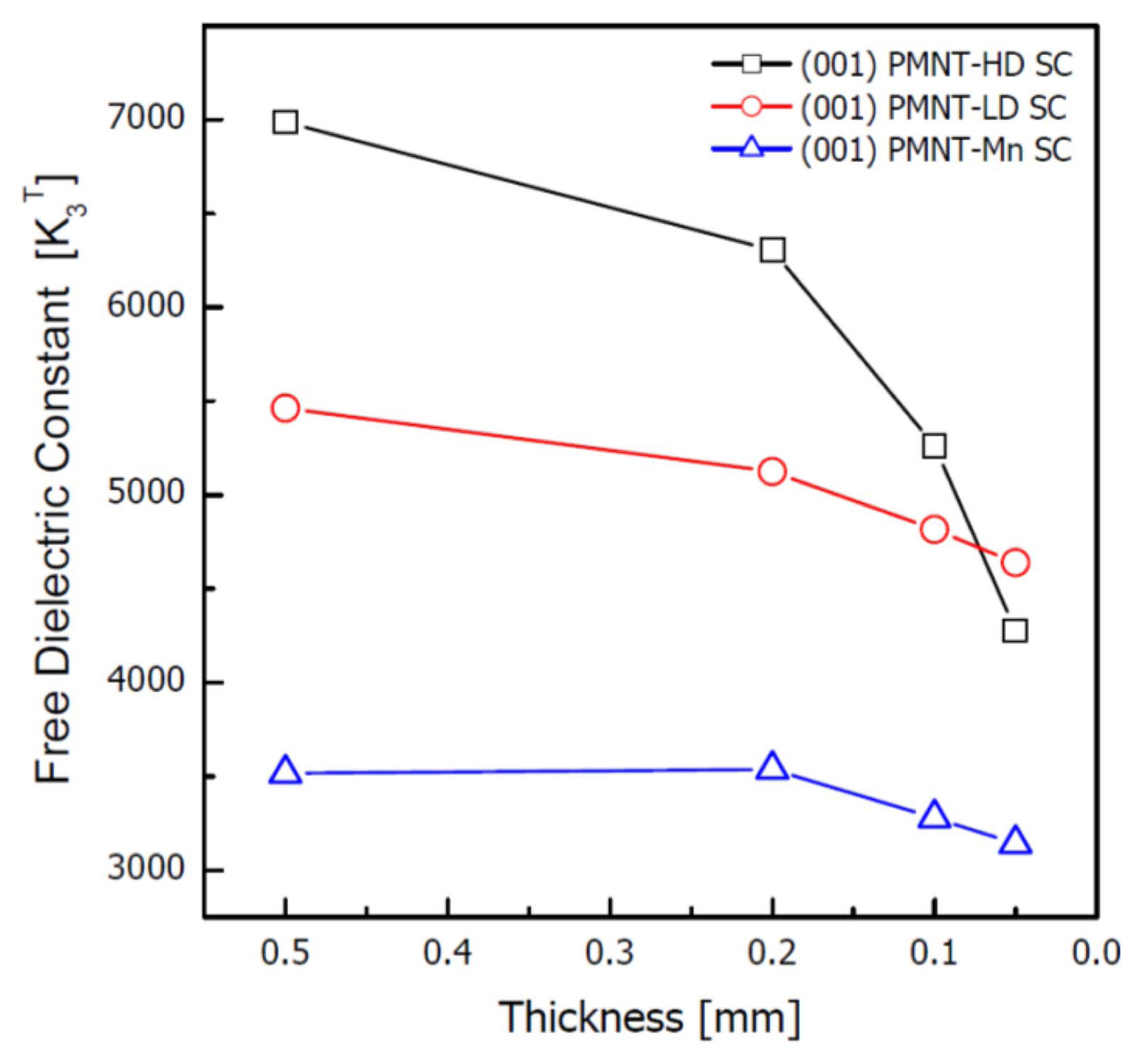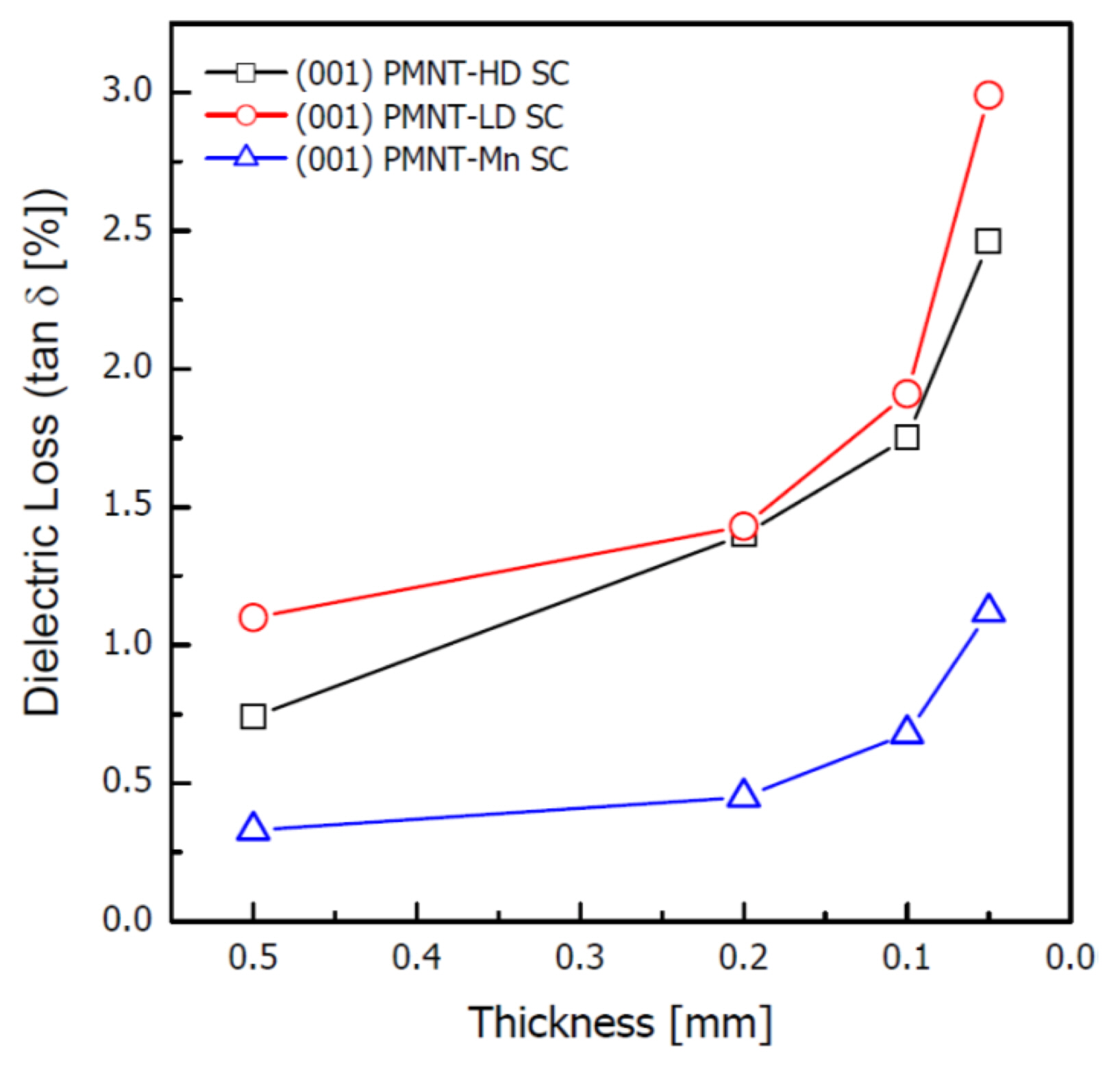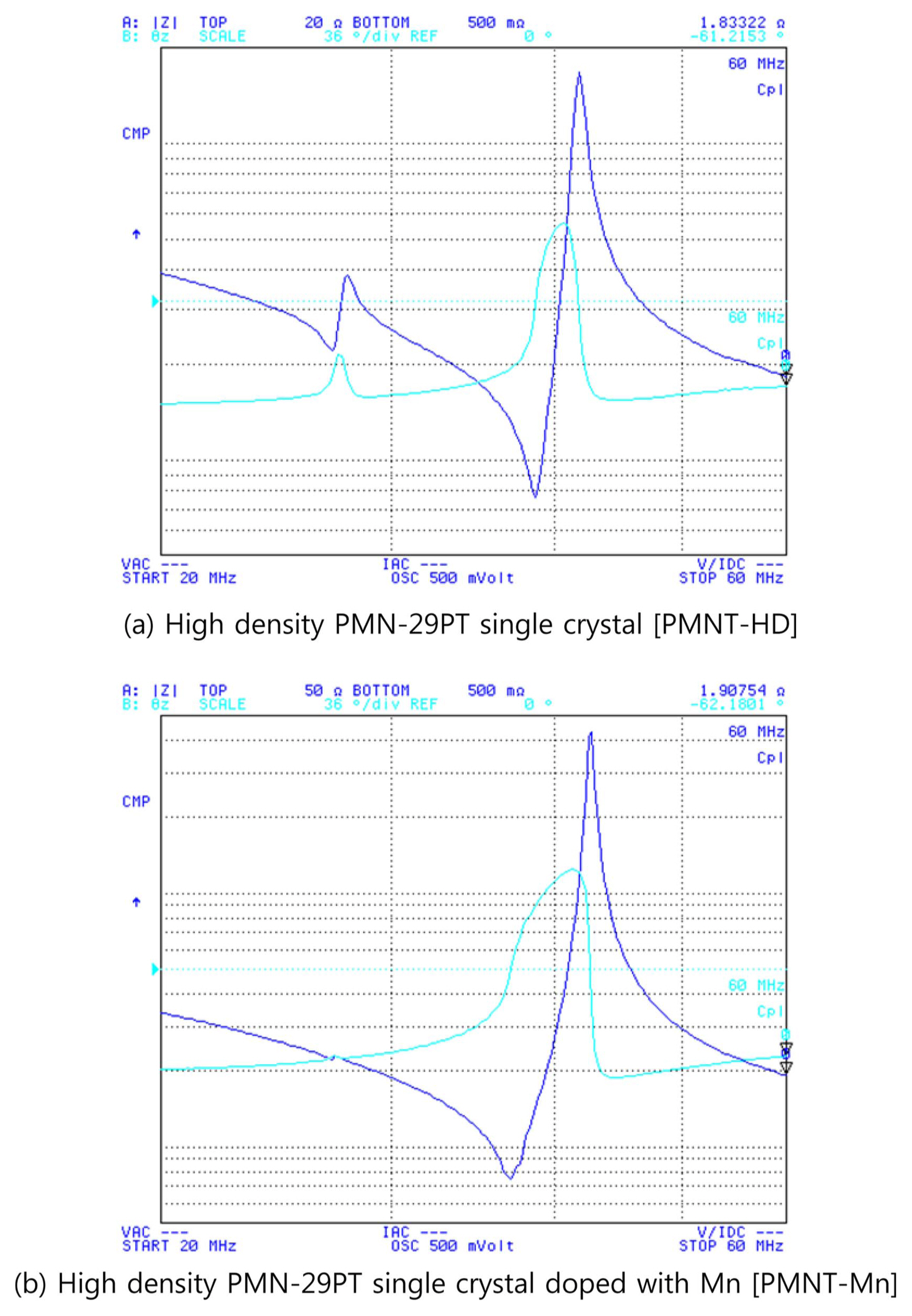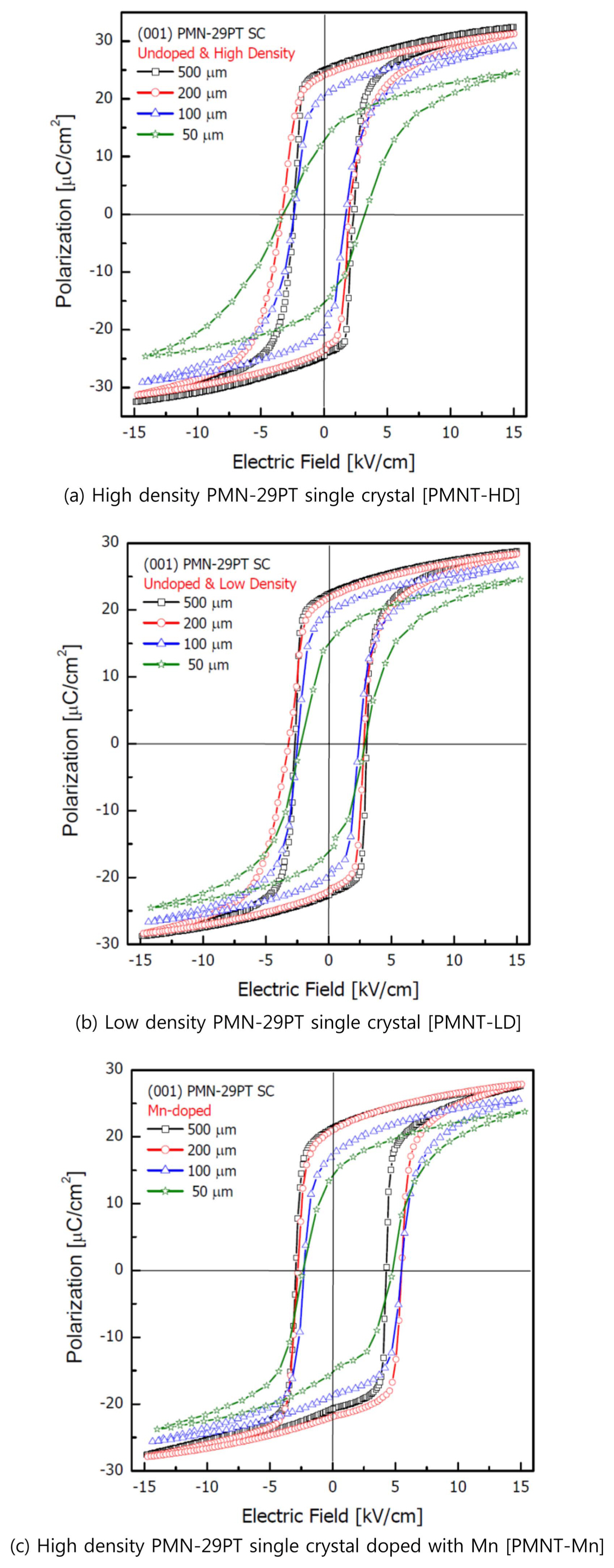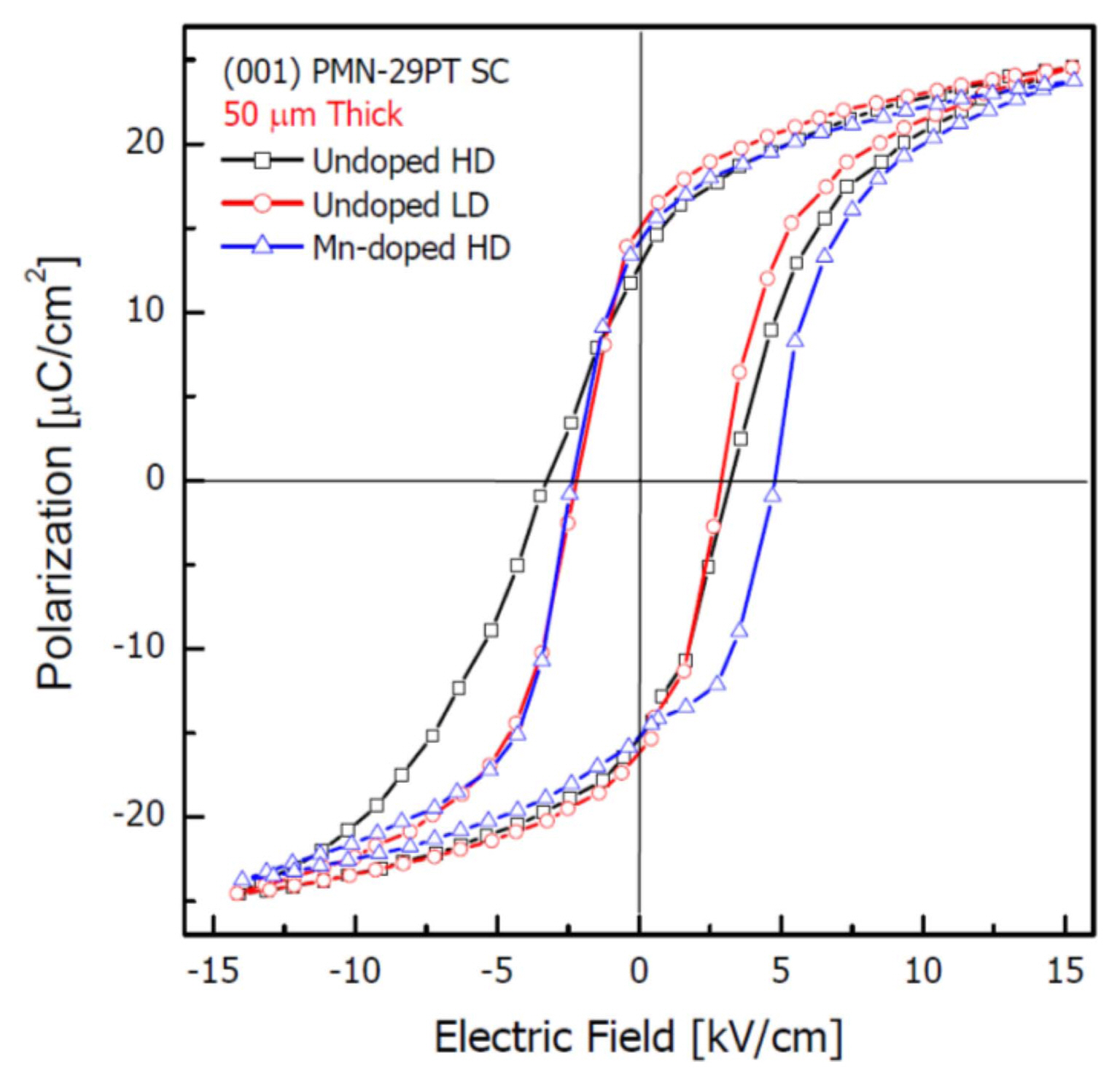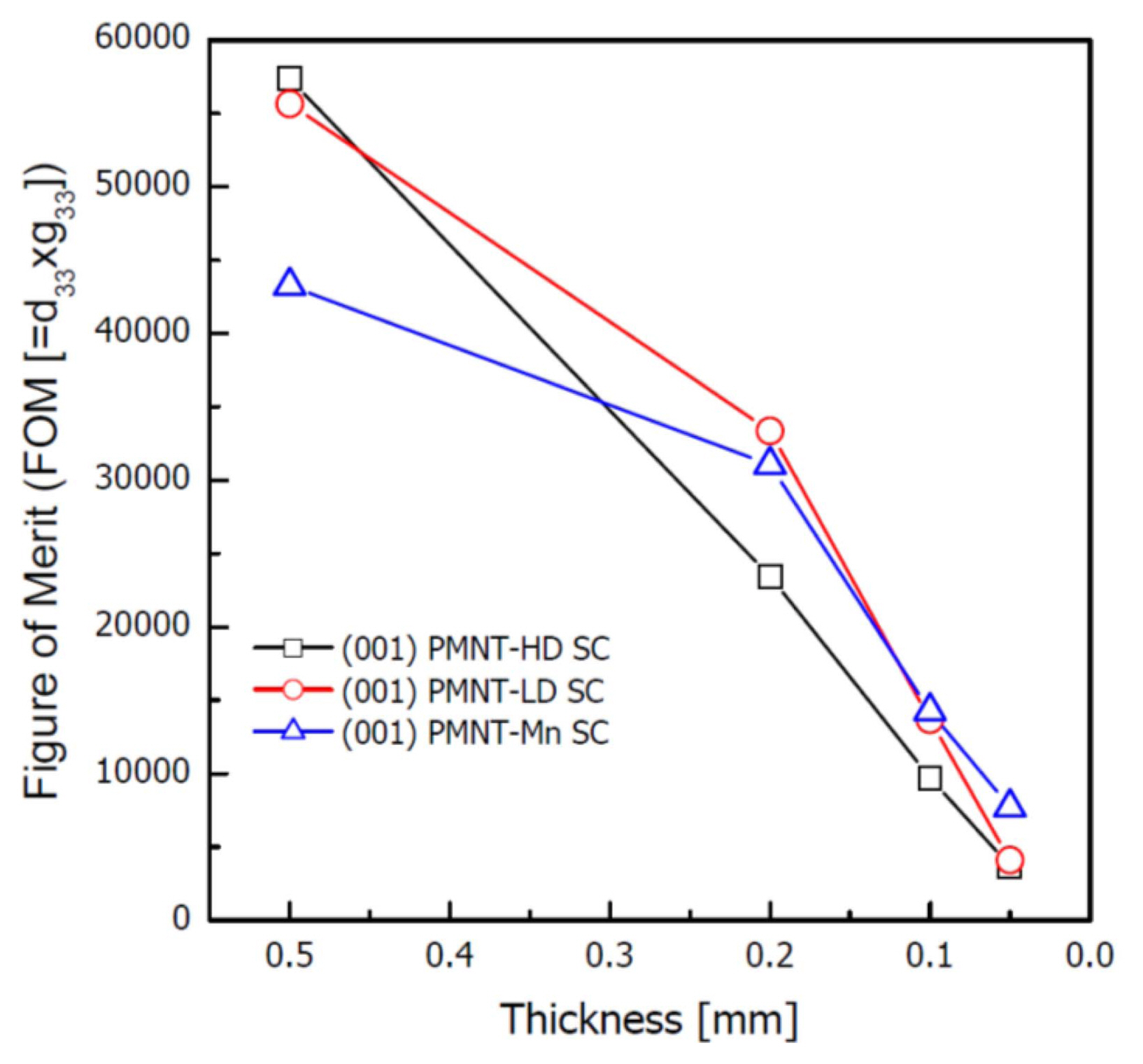1. Introduction
The PZN-PT [Pb(Zn1/3Nb2/3)O3-PbTiO3] and PMN-PT [Pb(Mg1/3Nb2/3)O3-PbTiO3] single crystals developed by the research teams of Tokyo Institute of Technology Professor Kuwata in the 1980s and Pennsylvania State University Professor Tom Shrout in the 1990s were reported to have piezoelectric constant (d33) values of over 1,500 pC/N and electromechanical coupling factor (k33) values of over 0.9.1,2) These PMN-PT piezoelectric single crystals have piezoelectric constant (d33) values that are multitudes greater than those of the piezoelectric PZT [Pb(Zr,Ti)O3] polycrystalline ceramics most widely used up to now,3) and the development of piezoelectric single crystals brought about significant changes to the research and market of piezoelectric materials and applications.4-6) After the development of piezoelectric single crystals, Philips and Humanscan began development for application of piezoelectric single crystals to medical ultrasound devices and, currently, medical piezoelectric single crystal ultrasound devices have become commercialized by various companies including Philips, Humanscan, GE, Siemens, and Hitachi.4-6) Beginning with the commercialization of a medical ultrasound device, applications are being attempted in various fields including SONAR transducers, medical high-intensity focused ultrasound (HIFU), acoustic sensors, piezoelectric actuators, ultrasonic motors, and piezoelectric energy harvesters.4-9)
High frequency piezoelectric composites, high frequency medical ultrasound device probes, high frequency industrial non-destructive test ultrasound probes, and flexible devices (actuators, sensors, speakers, energy harvesters, etc.), which are currently under development, utilize very thin piezoelectric single crystals with thicknesses below 0.2 mm.4-9) However, there have been many reports of applications using such thin piezoelectric single crystals in which the piezoelectric single crystal application component did not exhibit the expected properties and characteristics.10-12) Such degradation of dielectric and piezoelectric properties has been reported to be the result of local depoling caused by decreased thickness of the piezoelectric PMN-PT single crystal.10-12) Therefore, understanding the cause behind property changes according to the piezoelectric single crystal thickness change and developing a method of maintaining the piezoelectric single crystal properties for thicknesses below 0.2 mm have become important.
In this study, the solid-state single crystal growth (SSCG) method was used13-17) to fabricate 3 types of piezoelectric single crystals ((1) high density PMN-29PT single crystal [PMNT-HD], (2) low density PMN-29PT single crystal [PMNT-LD], and (3) Mn doped high density PMN-29PT single crystal [PMNT-Mn]). The dielectric and piezoelectric property changes according to the thickness were investigated for the 3 types of piezoelectric single crystals and the effects of the Mn addition and porosity were analyzed. Finally, appropriate piezoelectric single crystals were presented for applications including high frequency composites, high frequency medical ultrasound probes, high frequency industrial non-destructive test probes, and flexible devices (actuators, sensors, speakers, energy harvesters, etc.).
2. Experimental Procedure
In this study, SSCG was used to fabricate 3 types of piezoelectric single crystals ((1) high density PMN-29PT single crystal [PMNT-HD], (2) low density PMN-29PT single crystal [PMNT-LD], and (3) Mn doped high density PMN-29PT single crystal [PMNT-Mn]) at Ceracomp Co., LTD..13-17) Pb3O4 (99.9%, Alfa Aesar, Ward Hill, MA), MgNb2O6 (99.9%, H. C. Starck GmbH, Newton, MA), and TiO2 (99.99%, Ishihara, San Francisco, CA) were used as the raw ingredient powders. After quantifying each raw material powders, ball milling was conducted for 24 h, followed by drying and calcination at 800°C. The calcinated powders underwent secondary ball milling with excess amounts of PbO powder and the final powder was fabricated after drying and filtering through a sieve. Hot pressing and pressureless sintering were used to fabricate the high density and low density polycrystalline ceramics. The high density piezoelectric single crystals of relative density over 99% were produced by growing single crystals from the high density piezoelectric ceramic produced using the hot pressing method (1,050°C, 10 min, 50 MPa). The low density piezoelectric single crystals with relative density of around 95% were fabricated by growing single crystals from the low density piezoelectric ceramic produced using the conventional pressureless sintering method (1,250°C, 1 h). The Ba(Zr0.1Ti0.9)O3 seed single crystal was placed on top of the fabricated ceramic sintered body and heat treatment was carried out for SSCG. This heat treatment for SSCG was carried out using the double crucible method to prevent the loss of PbO, which is very volatile. During the single crystal growth heat treatment process, the Ba(Zr0.1Ti0.9)O3 seed single crystal was continuously grown within the polycrystalline ceramic, resulting in the production of 30 × 30 × 5 mm3 single crystals.
The fabricated piezoelectric single crystals were cut to prepare plate type (001) plane single crystals. Also, after the single crystal cutting, a wrapping process (cross section wrapping, WA #3000 [Sankei, Japan] abrasive) was used to prepare single crystal measurement specimens of (1) 0.5 mm, (2) 0.2 mm, (3) 0.1 mm, and (4) 0.05 mm thicknesses. Sputtering was conducted on the surfaces of the prepared measurement specimens to establish Au electrodes. The dielectric and piezoelectric properties of the prepared piezoelectric single crystals were measured in accordance with IEEE standards.18,19) Also, the dielectric and piezoelectric properties of the measurement specimens with various thicknesses were measured to investigate the effect of thickness.
3. Results and Discussion
3.1. Dielectric Constant and Dielectric Loss Variation According to Thickness
Prior to investigating the electrical properties of the 3 types of piezoelectric single crystals fabricated using SSCG, the relative densities of each single crystals were measured. The theoretical density of the PMN-29PT piezoelectric single crystal is 8.1 g/cm3,1,2) and the densities of the high density PMN-29PT single crystal [PMNT-HD], low density PMN-29PT single crystal [PMNT-LD], and Mn doped high density PMN-29PT single crystal [PMNT-Mn] were measured at 8.02 g/cm3, 7.70 g/cm3, and 7.98 g/cm3, respectively; their calculated relative densities were 99.0%, 95.0%, and 98.5%, respectively. These results show that the hot pressing process was effective in increasing the density of single crystals.
Figure 1 shows the dielectric constant according to the thicknesses for the 3 types of piezoelectric single crystals. While the dielectric constant of the high density PMN-29PT single crystal [PMNT-HD] was around 7,000 for the thickness of 0.5 mm, the dielectric constant for the thickness of 0.05 mm was lower at 4,280. The dielectric constant of the low density PMN-29PT single crystal [PMNT-LD] was around 5,460 for the thickness of 0.5 mm and lower at 4,640 for the decreased thickness of 0.05 mm. The dielectric constant of the Mn doped high density PMN-29PT single crystal [PMNT-Mn] was around 3,520 for the thickness of 0.5 mm and lower at 3,140 for the decreased thickness of 0.05 mm. These results show that the dielectric constant decreased as the piezoelectric single crystal thickness decreased and the rate of dielectric constant decrease with thickness is significantly reduced when pores or Mn were added to the high density PMN-29PT single crystal [PMNT-HD]. In particular, decrease in the dielectric constant due to the decreased thickness was smallest for the Mn doped case.
Figure 2 shows the dielectric loss (tan δ [%]) according to the thickness for the 3 types of piezoelectric single crystals. While the dielectric loss of the high density PMN-29PT single crystal [PMNT-HD] was around 0.7% for the thickness of 0.5 mm, the dielectric loss increased to around 2.5% when the thickness was decreased to 0.05 mm. The dielectric loss of the low density PMN-29PT single crystal [PMNT-LD] was around 1.1% for the thickness of 0.5 mm and increased approximately 3.0% for the decreased thickness of 0.05 mm. The dielectric loss of the Mn doped high density PMN-29PT single crystal [PMNT-Mn] was around 0.3% for the thickness of 0.5 mm and increased to 1.1% for the decreased thickness of 0.05 mm. These results show that the dielectric loss increased as the thickness of the piezoelectric single crystal decreased. Especially, the dielectric loss increased rapidly for thicknesses below 0.1 mm. However, the Mn doped high density PMN-29PT single crystal [PMNT-Mn] showed low dielectric losses of below 1% for the whole thickness range, showing that the addition of Mn was effective at maintaining the low dielectric loss.
3.2. Piezoelectric Charge Constant [d33] and Piezoelectric Voltage Constant [g33] Variations According to Thickness
Figure 3 shows the piezoelectric charge constant [d33] variation according to the thickness for the 3 types of piezoelectric single crystals. While the piezoelectric charge constant of the high density PMN-29PT single crystal[PMNT-HD] was around 1,880 pC/N for the thickness of 0.5 mm, the piezoelectric charge constant significantly decreased to 375 pC/N for the thickness of 0.05 mm. The piezoelectric charge constant of the low density PMN-29PT single crystal [PMNT-LD] was around 1,640 pC/N for the thickness of 0.5 mm and decreased to 410 pC/N for the decreased thickness of 0.05 mm. The piezoelectric charge constant of the Mn doped high density PMN-29PT single crystal [PMNT-Mn] was around 1,160 pC/N for the thickness of 0.5 mm and decreased to 463 pC/N for the decreased thickness of 0.05 mm. The piezoelectric charge constant decrease due to the decreased thickness was greatest for the high density PMN-29PT single crystal [PMNT-HD] and smallest for the Mn doped high density PMN-29PT single crystal [PMNT-Mn]. Comparison of the piezoelectric charge constants for the 3 types of piezoelectric single crystals revealed that the piezoelectric charge constant for the high density PMN-29PT single crystal [PMNT-HD] was highest for the thickness of 0.5 mm, while the Mn doped high density PMN-29PT single crystal [PMNT-Mn] showed the highest piezoelectric charge constant for the thickness of 0.05 mm. It was observed that the piezoelectric charge constant [d33] of the Mn doped high density PMN-29PT single crystal [PMNT-Mn] was highest for thicknesses below 0.1 mm since the piezoelectric constant decrease due to thickness decrease was smallest.
Figure 4 shows the piezoelectric voltage constant[g33] variation according to the thickness for the 3 types of piezoelectric single crystals. While the piezoelectric voltage constant of the high density PMN-29PT single crystal[PMNT-HD] was around 30.5 [mV·m/N] for the thickness of 0.5 mm, the piezoelectric voltage constant decreased to 9.9 [mV·m/N] for the decreased thickness of 0.05 mm. The piezoelectric voltage constant of the low density PMN-29PT single crystal [PMNT-LD] was around 33.9 [mV·m/N] for the thickness of 0.5 mm and decreased to 10.0 [mV·m/N] for the decreased thickness of 0.05 mm. The piezoelectric voltage constant of the Mn doped high density PMN-29PT piezoelectric single crystal [PMNT-Mn] was around 37.5 [mV·m/N] for the thickness of 0.5 mm and decreased to 16.7 [mV·m/N] for the decreased thickness of 0.05 mm. These results show that the piezoelectric voltage constant decreased as the thickness decreased for all 3 types of piezoelectric single crystals. Comparison of the piezoelectric voltage constant for the 3 types of piezoelectric single crystals showed that the piezoelectric voltage constant for the Mn doped high density PMN-29PT single crystal [PMNT-Mn] was the highest for the whole thickness range. In particular, it was observed that the piezoelectric voltage constant [g33] was more than double that of the other single crystals for the thickness of 0.05 mm.
3.3. Thickness Mode Electromechanical Coupling Factor (kt) Variation According to Thickness
Figure 5 shows the thickness mode electromechanical coupling factor (kt) variation according to the thickness for the 3 types of piezoelectric single crystals. While the thickness mode electromechanical coupling factor (kt) of the high density PMN-29PT single crystal [PMNT-HD] was around 0.54 for the thickness of 0.5 mm, the thickness mode electromechanical coupling factor (kt) decreased to 0.49 for the decreased thickness of 0.05 mm. The thickness mode electromechanical coupling factor (kt) of the low density PMN-29PT single crystal [PMNT-LD] was around 0.57 for the thickness of 0.5 mm and decreased to 0.53 for the decreased thickness of 0.05 mm. The thickness mode electromechanical coupling factor (kt) of the Mn doped high density PMN-29PT single crystal [PMNT-Mn] was around 0.57 for the thickness of 0.5 mm and decreased to 0.54 for the decreased thickness of 0.05 mm. These results show that the thickness mode electromechanical coupling factor (kt) decreased as the thickness of the piezoelectric single crystal decreased and that the decrease rates of the thickness mode electromechanical coupling factor (kt) for all 3 types of piezoelectric single crystals were similar to each other. Comparison of the thickness mode electromechanical coupling factor (kt) for the 3 types of piezoelectric single crystals revealed that the thickness mode electromechanical coupling factor (kt) of the high density PMN-29PT single crystal [PMNT-HD] was the lowest for the whole thickness range. Also, the thickness mode electromechanical coupling factor (kt) of the Mn doped high density PMN-29PT single crystal [PMNT-Mn] for thicknesses of lower than 0.1 mm was the highest.
Figure 6 shows the impedance curves of the (a) high density PMN-29PT single crystal [PMNT-HD] and (b) Mn doped high density PMN-29PT single crystal [PMNT-Mn] of 0.05 mm thickness near their thickness mode resonant frequency. Only thickness mode resonance was observed for the impedance curve of the Mn doped high density PMN-29PT single crystal [PMNT-Mn] (Fig. 6(b)). However, thickness mode resonance and a pseudo vibration mode (spurious peak) of relatively small magnitude were observed for the impedance curve of the high density PMN-29PT single crystal [PMNT-HD] (Fig. 6(a)). In the results of a previous study, a depoling phenomenon was observed due to the change in the domain structure for parts of the single crystal when the thickness of the piezoelectric PMN-PT single crystal decreased.12) As shown in Fig. 6(a), when depoling occurs due to the domain structure change of the piezoelectric single crystal, the pseudo vibration mode (spurious peak) was observed in addition to the thickness mode resonance peak.12) Therefore, due to the observation of the pseudo vibration mode in Fig. 6(b), it was found that depoling occurs for the 0.05 mm thick high density PMN-29PT single crystal [PMNT-HD].
The dielectric loss drastically increased for the high density PMN-29PT single crystals [PMNT-HD] of thicknesses below 0.2 mm (Fig. 2), and this dielectric loss increase, along with the appearance of the pseudo vibration mode shown in Fig. 6(a), is thought to be due to the depoling phenomenon of the single crystals. Therefore, the dielectric and piezoelectric properties decreased due to the local depoling of the high density PMN-29PT single crystal [PMNT-HD], caused by the decrease in thickness. The dielectric loss for the Mn doped high density PMN-29PT single crystal [PMNT-Mn] was about 1.1% and no pseudo vibration mode was observed other than the thickness mode resonance peak, so it was observed that depoling was minimal. Since depoling barely occurred for the Mn doped high density PMN-29PT single crystal [PMNT-Mn], the decreases in the dielectric and piezoelectric properties from the thickness decrease were very small.
3.4. Polarization and Coercive Electric Field Properties
The polarization and coercive electric field (EC) were measured according to the electrical field variation for the 3 types of piezoelectric single crystals (Fig. 7). Fig. 7(a) shows the polarization and coercive electric field variation according to the thickness for the high density PMN-29PT single crystal [PMNT-HD]. While the changes in the polarization and coercive electric field for thicknesses over 0.1 mm were small, the polarization decreased rapidly when the coercive electric field increased sharply for the thickness of 0.05 mm. However, for the low density PMN-29PT single crystal [PMNT-LD] (Fig. 7(b)) and Mn doped high density PMN-29PT single crystal [PMNT-Mn] (Fig. 7(c)), rapid changes in the polarization and coercive electric field were not observed for the whole thickness range. In particular, an internal electric field was observed for the Mn doped high density PMN-29PT single crystal [PMNT-Mn]. Similar to the case of PZT ceramic, when an acceptor like Mn is added to a high density PMN-29PT single crystal [PMNT-Mn], oxygen vacancies are formed and the defects of the acceptor and oxygen vacancies combine to create a defect dipole.20-24) This formation of a defect dipole has been reported to ultimately create an internal electric field within the crystal.20-24)
Figure 8 compares the polarization and the coercive electric field according to the electric field variation for the 3 types of piezoelectric single crystals of 0.05 mm thickness. When compared with the coercive electric field of the 0.5 mm thick single crystals, the coercive electric field of the 0.05 mm thick high density PMN-29PT single crystal [PMNT-HD] increased by more than 30%, while the coercive electric fields of the low density PMN-29PT single crystal [PMNT-LD] and Mn doped low density PMN-29PT single crystal showed no differences. The coercive electric field variation of the Mn doped high density PMN-29PT single crystal [PMNT-Mn] for the whole thickness range was smallest and the internal electric field was maintained. The maintenance of the dielectric and piezoelectric properties for the Mn doped high density PMN-29PT single crystal [PMNT-Mn] is thought to result from the lack of depoling for the whole thickness range due to the high coercive and internal electric field.
3.5. Piezoelectric Energy Harvesting Performance Prediction According to Thickness
Table 1 shows the dielectric and piezoelectric properties of the high density PMN-29PT single crystal [PMNT-HD], low density PMN-29PT single crystal [PMNT-LD], and Mn doped high density PMN-29PT single crystal [PMNT-Mn]. While the dielectric constant and piezoelectric constant were highest for the 0.5 mm thick high density PMN-29PT single crystal [PMNT-HD], the coercive electric field was smallest and no internal electric field was observed. Also, the dielectric and piezoelectric constants (d33, g33) rapidly decreased when the thickness was decreased. When the porosity was increased by about 4% for the high density PMN-29PT single crystal [PMNT-HD] (in other words, the low density PMN-29PT single crystal [PMNT-LD]), the dielectric constant and piezoelectric charge constant (d33) decreased for the thickness of 0.5 mm, while the piezoelectric voltage constant (g33) and thickness mode electromechanical coupling factor (kt) increased. When the thickness decreased, the decrease rate of the dielectric and piezoelectric constants (d33, g33) decreased compared to those of the high density PMN-29PT single crystal [PMNT-HD]. Due to this property of decrease rate difference according to thickness variation, the coercive electric field, piezoelectric constant (d33, g33), and thickness mode electromechanical coupling factor (kt) were higher for thicknesses below 0.2 mm. When Mn was added to the high density PMN-29PT single crystal [PMNT-HD] (in other words, the Mn doped high density PMN-29PT single crystal [PMNT-Mn]), the dielectric constant, dielectric loss, and piezoelectric charge constant (d33) decreased rapidly and were the smallest for the thickness of 0.5 mm. However, the coercive electric field increased by about 50% and an internal electric field was induced, resulting in the highest coercive electric field; piezoelectric voltage constant (g33) and thickness mode electromechanical coupling factor (kt) were also at their highest. When the thickness was decreased, the decrease rates for the dielectric loss and piezoelectric constant (d33, g33) were smallest compared to the other 2 types of single crystals. Due to the property decrease rate difference according to the thickness variation, the electric loss was smallest for thicknesses below 0.1 mm and the piezoelectric constant (d33, g33), thickness mode electromechanical coupling factor (kt), coercive electric field, and internal electric field were highest.
These results show that porosity and Mn addition had significant impacts on the property variation of the PMN-29PT piezoelectric single crystal according to the thickness variation. Such influence is thought to be due to the occurrence of depoling from the local domain structure change within the single crystal, caused by thickness decrease in the thickness range below 0.2 mm. This depoling phenomenon is inhibited by the porosity or Mn within the single crystal.20-24) In particular, Mn addition was most effective, and the Mn doped high density PMN-29PT piezoelectric single crystal [PMNT-Mn] showed the highest dielectric and piezoelectric properties for thicknesses below 0.2 mm. These results reveal that the Mn doped PMN-PT single crystal was most suitable for applications, including high frequency piezoelectric composites, high frequency medical ultrasound device probes, high frequency industrial non-destructive test probes, and flexible devices (actuators, sensors, speakers, energy harvesters, etc.) where the use of piezoelectric single crystals with thicknesses below 0.2 mm is necessary.
To compare the piezoelectric energy harvesting property of each piezoelectric single crystal according to the thickness variation, the Figure of Merit (FOM), which represents the piezoelectric energy harvesting property, was defined as “d33·g33” (Fig. 9). For all 3 types of single crystal, FOM decreased as the thickness decreased. For the thickness of 0.5 mm, the FOM for the high density PMN-29PT single crystal [PMNT-HD] was highest, while the FOM for the low density PMN-29PT single crystal [PMNT-LD] was highest for the thickness of 0.2 mm. However, for the thicknesses of 0.1 and 0.05 mm, the FOM for the Mn doped high density PMN-29PT piezoelectric single crystal [PMNT-Mn] was highest. In the case of piezoelectric energy harvesting applications, in which external mechanical stress and deformation are applied repetitively to the piezoelectric single crystal, high FOM is very important, along with stability of the piezoelectric single crystal mechanical and electrical properties. The Mn doped high density PMN-29PT piezoelectric single crystal [PMNT-Mn] is predicted to not only have high FOM but also to exhibit electrical stability due to the internal electric field and very high coercive electric field. Therefore, it was shown that the Mn doped PMN-PT single crystal can be applied to flexible piezoelectric energy harvesters, which have been actively studied recently worldwide.8,9,25-27)
4. Conclusions
In this study, dielectric and piezoelectric property variations were investigated for 3 types of piezoelectric single crystals ((1) high density PMN-29PT single crystal [PMNT-HD], (2) low density PMN-29PT single crystal [PMNT-LD], and (3) Mn doped high density PMN-29PT single crystal [PMNT-Mn]). Also, the property variations for the 3 types of single crystals were compared and the impacts of porosity and Mn addition were analyzed with regard to the property variation of the piezoelectric single crystals according to the thickness. When the thickness was decreased, the dielectric and piezoelectric properties of the high density PMN-29PT single crystal [PMNT-HD] decreased sharply. Such property degradation due to thickness decrease resulted from the occurrence of depoling from the local domain structure within the single crystal; this depoling and a property degradation phenomenon were significantly inhibited by the presence of porosity or Mn within the single crystal. Especially, Mn addition was most effective, and the Mn doped high density PMN-29PT piezoelectric single crystal [PMNT-Mn] exhibited the highest dielectric and piezoelectric properties for thicknesses below 0.2 mm. In conclusion, it was found that the Mn doped PMN-PT single crystal was most suitable for applications that require the use of piezoelectric single crystals less than 0.2 mm thick, including high frequency piezoelectric composites, high frequency medical ultrasound device probes, high frequency industrial non-destructive test probes, and flexible devices (actuators, sensors, speakers, energy harvesters, etc.).









